
https://www.citicards.com/ this morning:
Error 404: No target servlet configured for uri: /cards/wv/home.do
The Citi Never Sleeps. Except when it does. 
Update: Service is back now. The Citi woke up.
Connecting the dots ...


https://www.citicards.com/ this morning:
Error 404: No target servlet configured for uri: /cards/wv/home.do
The Citi Never Sleeps. Except when it does. 
Update: Service is back now. The Citi woke up.

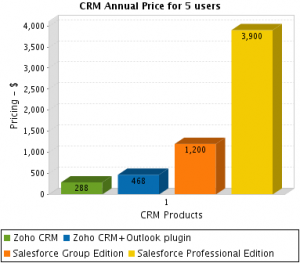
This morning Zoho announced the Enterprise Edition of their CRM product. The key updates are:

The key in “going enterprise” is no doubt the new security/permissioning scheme. That said, Zoho CRM has already been functionally rich even before today’s upgrade. I’ve repeatedly stated that supporting business processes like Sales Order Management, Procurement, Inventory Management, Invoicing Zoho really has a mini-ERP system, under the disguise of the CRM label. . In fact let’s just stop here for a minute.
. In fact let’s just stop here for a minute.
Today’s announcement aside, I still consider Zoho’s primary focus to be the small business (SMB) market. As for CRM, it really comes down to the classic breadth vs. depth of functionality question. Zoho CRM’s breadth, along with the other productivity applications allows many SMB’s to use it as their single, only business application. The market leader in SaaS CRM, Salesforce.com clearly supports fewer business processes, offering more depth in each – probably a better fit for larger enterprises which likely run several applications anyway. This matrix provides an overview of Zoho CRM vs. Salesforce CRM Group and Professional Editions. (click on pic for detail)
Having done a functional comparison, a quick look at pricing demonstrates why Zoho CEO Sridhar Vembu called Salesforce.com still very expensive:
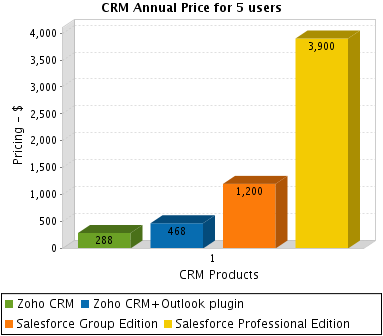
No wonder Larry Dignan at ZDNet declares “Zoho aims to poach Salesforce.com customers.” But Larry (and Marc), you ain’t seen nothing yet… just wait till Zoho comes out with a Salesforce.com importer  .
.
Clearly, Salesforce.com does keep a close eye on Zoho, otherwise why would they spend money on the Google Adword “Zoho CRM“?

But again, reality check: Salesforce.com does own the Enterprise space. For now.
Finally, a word about integration. After all, Zoho is known for their almost endless range of products, they should work together… Currently Zoho Sheet, the spreadsheet application is fully integrated with CRM – most data can be edited either inside CRM or in the spreadsheet format that many business users are more familiar with.
Zoho plans to integrate Writer, their word processor, Mail (still in private beta) as well as some of the business applications, namely recently released Invoice and People. When all that’s done, Zoho will have a more complete offering than two industry giants, Salesforce.com and Google together. I can’t wait…
(Disclaimer: I am an Advisor to Zoho. Take anything I say with a grain of salt. In fact with a pound of salt. Don’t believe a single word of mine about Zoho products: go ahead and check them out yourself).
Related posts: Zoho Blogs, CenterNetworks, VentureBeat, CNET News.com, Mashable!, Between the Lines, Web Worker Daily, Irregular Enterprise, InformationWeek,

I am a big fan of Software as a Service, but it frustrates the hell out of me to see industry pundits over-hype it without really understanding it. Here are 3 killer (in the bad sense) half-truths about SaaS:
1 – SaaS is simpler, easier to implement than On-premise software (see update at the bottom)
2 – SaaS is for the SMB market
3 – SaaS is bought, not sold, it’s the end of Enterprise Sales
Let’s examine them in detail:
1 – SaaS is simpler, easier to implement than On-premise software.
The only part that’s absolutely true is the technical installation, which the customer no longer has to worry about with SaaS. But we all know that this is a fraction of a typical implementation. Implementations are all about business process and training, hence the difficulty / duration / cost of an implementation depends on the complexity of business and the size of the organization – these two tend to correlate with each other.
It just so happens that all SaaS solutions so far have started (and many stay) at the SMB level, so they are simpler not by virtue of being SaaS but by their target market’s needs.
2 – SaaS is for the SMB market
Yes, traditionally all SaaS started with Small Businesses, but that does not mean it may not move upstream. Salesforce.com and several HCM applications have proven technical scalability, but they offer partial / departmental functionality.
I am a strong believer that in 4-5 years most software developed will be SaaS, and that in 10 years it will be the predominant method of “consuming” software by large enterprises – but I can’t prove it. There’s no empirical evidence, since there has not been any Integrated Enterprise SaaS available so far. The closest to it is NetSuite today (but it’s still SMB focused), and SAP’s Business ByDesign tomorrow. In fact despite SAP’s official positioning, driven by market focus and current limitations (functional and infrastructure), I believe that SAP will use BBD to learn the SaaS game – i.e. BBD will be a test bed for a future Enterprise SaaS offering. But we’re not there yet.
(longer discussion here)
3 – SaaS is bought, not sold, it’s the end of Enterprise Sales
Hey, I’ve said this myself, so it must be true (?). Well, it depends on the position of the sun, the constellation of the stars, and several other factors, but mostly the first two we’ve just covered.
SaaS for very small business: that’s the clear-cut lab case for the click-to buy pull model to work. In fact in this respect (sales model) I believe the business size is the no.1 determinator. Some solutions will have to be configured and may even require pre-sales business process consulting. This inflexion point will clearly be higher for functionally simpler solutions, like CRM and lower for integrated business management systems, like NetSuite or SAP’s Business ByDesign.
Once you reach that inflexion point, you’re in a more interactive, lengthier sales process, and that’s typically face to face. At least that’s what we’re conditioned to: but it does not have to be that way. That will be the subject of another post – to come soon.
Update: Ben Kepes challenged #1 on his blog, and to some extent I have to agree. My post here is continuation of a discussion we started at the virtual SAP Marketing Community Meeting, and my mind-set was still business process software, e.g. CRM, ERP..etc, but I forgot to specify that. Instead of replicating the argument, why don’t you read my response to his response at Ben’s place.

This is a shameless reprint of my post exactly two months ago:
Yahoo running to AOL to avoid assimilation by the (Micro-)Borg? Hm… I don’t know which one is worse. (Actually, I do.) The funny (actually, sad) thing is, most of my Best MicroHoo quotes apply to a Yahoo/AOL situation, you just have to replace Microsoft with AOL
Personally, I think the Microsoft and Yahoo matchup is like two tired swimmers who bump into each other and then wind up drowning each other in their scramble to survive. But Yahoo will be the first to go under in this embrace.
It’s like taking the two guys who finished second and third in a 100-yard dash and tying their legs together and asking for a rematch, believing that now they’ll run faster.
Imagine a circus act in which two enormous, clumsy, awkward elephants that don’t really like each other are supposed to mate while riding on skateboards.
Oh, well… a sad soap opera. 
Related posts (a few of the many): Silicon Alley Insider, TechCrunch, BoomTown, BloggingStocks, Technology news, Tech Beat, HipMojo.com, Deal Journal, Mark Evans, TECH.BLORGE.com, BuzzMachine , MarketingVOX

The cat is out of the bag – was my first reaction when FreshBooks announced the launch of their new benchmarking service in October 2006. Then, and later I called it the hidden business model in SaaS:
He basically announced the hidden value proposition enabled by SaaS: competitive benchmarking. All previous benchmarking efforts were hampered by the quality of source data, which, with all systems behind firewalls was at least questionable. SaaS providers will have access to the most authentic data ever, aggregation if which leads to the most reliable industry metrics and benchmarking.
With Google’s entry today, benchmarking is no longer the hidden business model: it has just gone mainstream. Potentially great value added service, a new revenue source for the provider, which may even allow them to give the core service away for free.
Give away? Do you think I’m smoking something? Read Jeremiah Owyang who predicted that storage companies will (?) eventually pay for your data. 
Related post: Dennis @ AccMan Pro,

Ok, I admit: it’s a bombastic title. Even worse, it’s stolen. I stole it from Entrepreneur – Startup CEO – Investor – Blogger Dharmesh Shah, who just explained why he hates Powerpoint, and we should, too. He points to Jeff Nolan’s post titled PowerPoint And The Spoken Word, which in turn links to Presentation Diva Laura “Pistachio” Fitton’s humorous piece, I don’t want them to be bored.
Client: “Should I have a PowerPoint?”
Pistachio: “Why?”
Client: “I don’t want them to be bored.”
Pistachio: “Then don’t.”
Pistachio: “Is there anything you need to tell them that you cannot do with your body or your voice?”
Client: “No.”
Pistachio: “There you go.”
Pistachio: “Uh, do you mind if I write this down for a blog post?”
The only reason the Presentation meme is not featured on TechMeme yet is that a good part of it is behind firewall, born at the SAP Marketing Community Virtual Meeting. So now I’m playing manual TechMeme, aggregating the conversation together here.
It all started by Laura giving practical advice on 10 Minutes to a Presentation that Rocks MUCH More. My favorite of her tips:
Lightning Round
Race through your presentation using no more than one sentence to explain each slide. Take no more than five seconds per slide. State the point in just one short remark. If you can’t, kill the slide. If you
can’t kill it, “maim” it until it has a point.
Then in Your Role-O-Deck (hm, I think I’ve just discovered another of her tricks, i.e. use killer titles) she speaks out against using “the deck”, a thick set of slides that are not used as visual aids by a live speaker, but as bastardized and poor replacement for MS Word, to write actual reports in SAP – in fact any large corporation.
My comment to her post is that the “ppt deck” is not only a corporate disease:
I’m involved with the startup community here, where the mentality is fresh thinking, “challenge all”, yet VC’s repeatedly ask startup Founders to send their “deck”. Deck is a nasty word, but describes what these bastardized “presentations” have become: thick and heavy.
My simple rule: if your deck is good enough to send in advance, i.e. it has enough content to convey the message, than you don’t have a presentation. Send the document, but develop another one you can use as visual aid to an actual live presentation.
Faheem Ahmed, VP of Portfolio Positioning and Messaging at SAP agrees in The myth of the “standalone” presentation:
Not all slides are presented. And there’s nothing wrong with using PPT to create useful diagrams or reports … it’s a tool just like any other. But then we shouldn’t call this set of slides a “presentation” any more. It’s a document.
He also talks against recycling presentations again and again, instead advises to define the strategic intent and develop specific ones.
So coming back to Dharmesh, does he really hate Powerpoint? No he doesn’t – not as a tool. He just hates “the deck”, and presentations that take over from the person who should be what we focus on. To illustrate his point, he shows us two examples, Mac vs. PC style:
Steve Jobs apparently wants the audience to listen to him tell the story, rather than read the slides:
Next comes a slide from Michael Dell. These are meant to be sent to someone who needs to get the full story looking at them, but when they are use as illustration to a live story, they become a distraction:
Dharmesh concludes:
If I had the talent and resources of Steve Jobs, I’d be able to create slides just fine. But I don’t (have the talent) and don’t have the resources) so I don’t like to create slides.
Hate PowerPoint because you love your audience.
I’m going to finish this with a quote from Jeff Nolan (hey, kids are always winners):
Powerpoint is like my 4 year old’s blanket, he can’t have his apple juice or go to sleep without it. Executives are afraid to not have Powerpoint, the big difference is that my 4 year old will eventually give up his blanket.


 This year’s TechCrunch 50 Conference is planned to coincide with DemoFall, the (other) premium startup Launch event.
This year’s TechCrunch 50 Conference is planned to coincide with DemoFall, the (other) premium startup Launch event.
VentureBeat attempts to (well, sort of) explain it with scheduling, but make no mistake, this is a fairly open move against DemoFall, to establish TechCrunch50 as the premier startup launch event. There’s no question that TechCrunch can pull in just about the entire VC community – in fact given the audience pricing, $2000 early bird, and $3000 regular, it’s hard to believe anyone but VCs can afford to attend. Well, VCs and students, as those with a student ID can get in for $149.
The presenting companies will not be charged – that’s a huge differentiate vs. Demo. As I said before, you almost have to be already funded to be able to afford Demo’s fees. I leave it to you to decide which one is more startup-friendly.
Of course they want a real launch show, so the one hard condition is that your product /service will have to be new (unseen) at the Conference. Several commenters are already complaining that they are launching before September, which automatically disqualifies them.
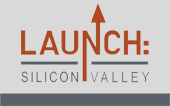 I have a solution for you “early birds”: come join us at Launch: Silicon Valley 2008 jointly presented by SVASE and Garage Technology Ventures. Five of last year’s 29 presenters received venture funding, in aggregate of $30M. That’s not $140M, but not too shabby, either
I have a solution for you “early birds”: come join us at Launch: Silicon Valley 2008 jointly presented by SVASE and Garage Technology Ventures. Five of last year’s 29 presenters received venture funding, in aggregate of $30M. That’s not $140M, but not too shabby, either .
.
How to participate? If by June 10th, 2008 (the day of the event) you will have a product or service available, but have not been out in the marketplace for more than a few months, then send an Executive Summary of no more than 2 pages to Launchsv@svase.org. Submission deadline: May 9th, 2008. (Garage Technology offers a useful Writing a Compelling Executive Summary guide.) Last year’s 30 (actually, 29) presenting startups were selected from 170 submissions. For details – and attendee registration – check out http://www.launchsiliconvalley.org/.
See you there!
Related posts: bub.blicio.us, Valleywag, Jason Calacanis, SheGeeks, ValleyWag, News.com, Silicon Alley Insider, : WinExtra, CenterNetworks, mathewingram.com/work, BoomTown, The Drama 2.0 Show, Geek Gestalt, /Message

 After a long break I’ll be moderating another SVASE VC Breakfast Club meeting next Thursday, April 3rd in San Francisco. As usual, it’s an informal round-table where 10 entrepreneurs get to deliver a pitch, then answer questions and get critiqued by a VC Partner. We’ve had VC’s from Draper Fisher, Kleiner Perkins, Mayfield, Mohr Davidow, Emergence Capital …etc. This time we”ll have the honor of welcoming Ann Winblad, Partner, co-Founder of the first exclusively software-focused venture firm, Hummer Winblad Venture Partners.
After a long break I’ll be moderating another SVASE VC Breakfast Club meeting next Thursday, April 3rd in San Francisco. As usual, it’s an informal round-table where 10 entrepreneurs get to deliver a pitch, then answer questions and get critiqued by a VC Partner. We’ve had VC’s from Draper Fisher, Kleiner Perkins, Mayfield, Mohr Davidow, Emergence Capital …etc. This time we”ll have the honor of welcoming Ann Winblad, Partner, co-Founder of the first exclusively software-focused venture firm, Hummer Winblad Venture Partners.
These breakfast meetings are a valuable opportunity for Entrepreneurs, most of whom would probably have a hard time getting through the door to VC Partners. Since I’ve been through quite a few of these sessions, both as Entrepreneur and Moderator, let me share a few thoughts:
Here’s the event info page, and remember to register – the previous event with Hummer Winblad sold out in advance.
See you in San Francisco!

 Yes, the title isn’t a mistake: TechCrunch is no longer just powerful media, Mike now can single-handedly release new products.
Yes, the title isn’t a mistake: TechCrunch is no longer just powerful media, Mike now can single-handedly release new products. . Today I spent several hours testing a pre-release product, Zoho Invoice, which was a few weeks from it’s planned launch, when TechCrunch accidentally posted the news. The Zoho Team decided to play along, and instead of disappointing TC readers with a broken link, opted to release the product immediately.
. Today I spent several hours testing a pre-release product, Zoho Invoice, which was a few weeks from it’s planned launch, when TechCrunch accidentally posted the news. The Zoho Team decided to play along, and instead of disappointing TC readers with a broken link, opted to release the product immediately.
Not exactly an orderly Launch, but not the end of the world either, especially not for Zoho, which has a reputation of updating their web-based products frequently. In my early testing today I found Invoice easy to use, with a soothing, pleasant UI where all the icons are in the right place and support the right information flow. There are some features that were still under consideration as of this afternoon – so be it, this is a “forced” early release, updates and fixes will no doubt be coming soon (using the Feedback button at the top will help issues get fixed quickly).
So what do we have here? Essentially a billing application, that allows the user to create /import Clients, define items (product/service), generate estimates, convert them to invoice and accept payment against it. The Home screen is a Dashboard, providing a quick financial overview:
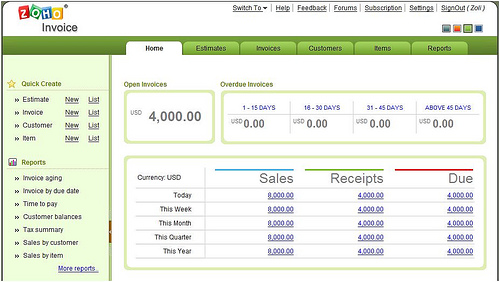
Information flows easily from one document to another, and there are a number of predefined (customizable) templates that can generate notification emails to the Customer at any stage. Notice the icons change on these two bars:


The Estimate (emailed or snail-mailed to the Customer) can be converted to an Invoice, but when displaying an Invoice, there’s a new icon there to enable entering a payment received.
There are transactional detail, summary, aging ..etc reports to help keep tight control of your receivables.
Although Zoho is primarily known for being the best Web-based Office / Productivity Suite provider, they are not exactly new to transactional business systems: their longest standing product is Zoho CRM (which is an understated name for a mini-ERP), the recently announced Zoho People, and a more full-featured Accounting system is in the works, too. Talk about CRM, it already has some Invoice functionality, which will later be replaced by the new module, to be integrated with CRM. For now, Zoho Invoice is integrated with Projects.
The slideshow below explains the setup, various functions and the workflow between them (click the lower right corner to switch to full-screen):
The new billing application is free up to 5 invoices a months, and there is a pricing scale depending on the number of invoices per month, from $5 incl. 25 invoices to $35 up to 1500 invoices.

The two notable competitors are BlinkSale and FreshBooks. Zoho will no doubt build on the fact that Invoice is just one piece in the puzzle of 16 or so business applications it has to offer.
(Disclaimer: I am an Advisor to Zoho)
Related posts: Webware.com, Enterprise Alley, Venture Beat, Zoho Blogs,


I’ve been observing an annoying trend on TechMeme for a while now: when a good discussion happens over the weekend, obviously some writers will miss it – then they sleep on it, come back to it a few days later and TechMeme picks it up as a new theme.
That’s what we’re seeing today with ZDNet blogger Ed Bott coming back to the Apple Update brouhaha and trying to place Microsoft on a morel higher ground.
In summary, the issue was that the Apple iTunes update program all of a sudden wanted to install the Safari browser on Windows PC’s and had it as the preselected default. That’s certified bad behavior. Even worse is the fact that it’s not new at all – a fact missed by almost all but yours truly. I pointed out that:
To me this was all about respecting users choice or not. But the discussion went the “wrong way”:
And now here comes Ed Bott with a provocative title: What Microsoft can teach Apple about software updates:
For the record, I think Apple is dead wrong in the way it’s gone about using its iPod monopoly to expand its share in another market.
Right.
Ironically, an excellent model for how this update program should work already exists. It’s called Windows Update, and it embodies all the principles that Apple should follow.
Dead wrong.
I can’t believe anyone in their right mind would quote Windows Update, known for delivering patches that mess up one’s system only to be patched again and again as the ideal model to follow. One does not have to go too far, just look at the reports on systems disabled by the recent Vista SP1 update. The worlds richest company could not put a decent operating system together in five years, and a full year later the best they can deliver is a botched update!
But since Ed takes the opportunity to place Microsoft on the moral high ground in general, let’s not forget about another recent Microsoft update coup:
The windows live installer, released last September while offered an opt-out screen like Apple does now, then proceeded to install Windows Desktop Search, without ever asking for permission or even notifying the user.

Not only this was outrageously bad practice, completely ignoring the users right to decide what they want on their computers, it was also performance degrading, especially on systems that already had another desktop search installed (see system bar above).
So back to Ed Bott: yes, I condemn Apple’s latest move, but please, please, never in a million years would I think of setting Microsoft as the model to follow.
Update: This window just popped up on my system:
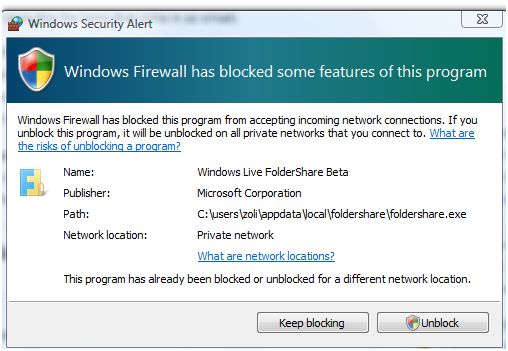
Windows Firewall blocked Foldershare – a Microsoft product, which just got updated a few days ago. Only (?) problem is, I have (I should have) Windows Firewall turned off, since McAfee is installed, too. WTF is this message? Or has Win Firewall been turned on by some update, without asking me? And why is it my job to investigate?
Related posts: Inner Exception, Tom Raftery’s Social Media and ParisLemon

Publisher / Editor of CloudAve and Enterprise Irregulars.
I do most of my business blogging there, with occasional asides here. More...
Copyright © 2025 · Mindstream Child Theme on Genesis Framework · WordPress · Log in
Recent Comments